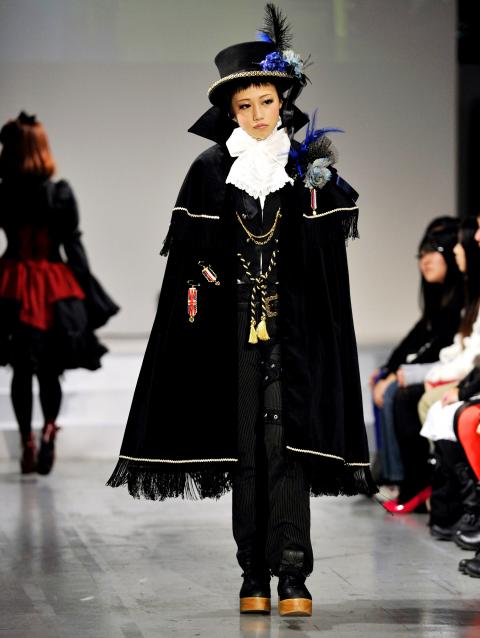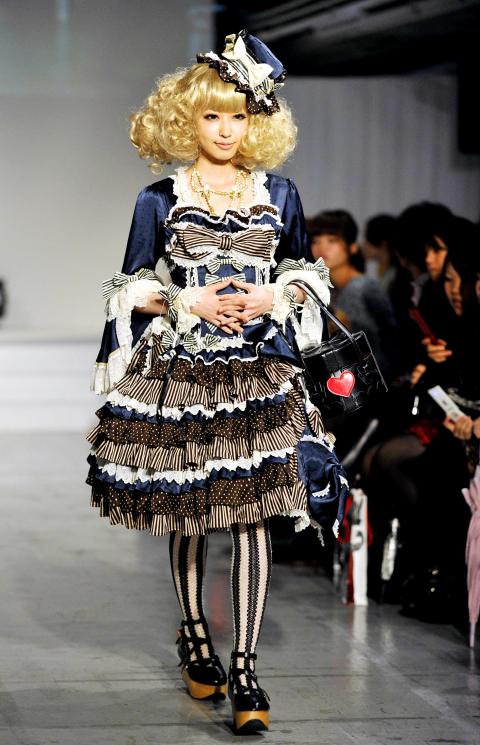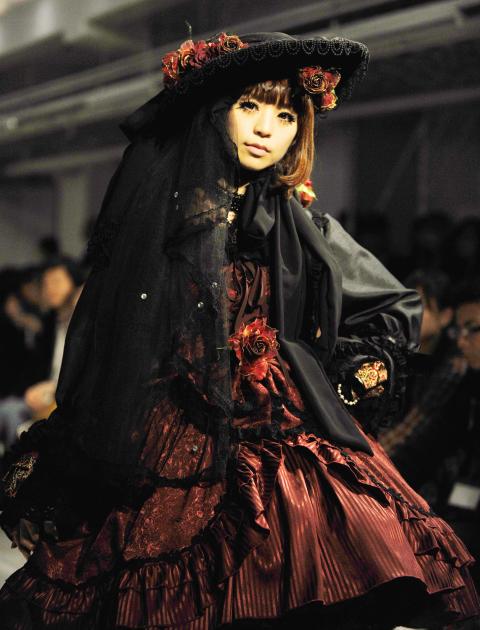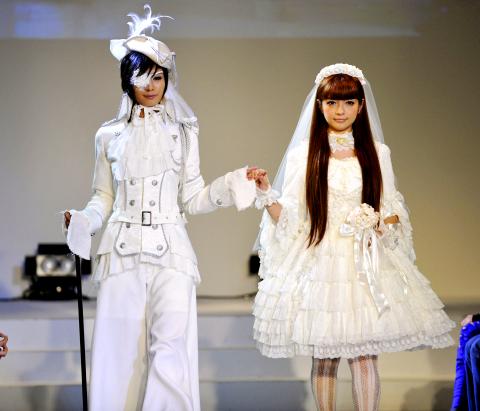Outlandish pannier skirts with layers of frilly lace; teenage girls with larger-than-life make-up; a dash of sexuality and lashings of Victoriana are the order of the day for Japan’s Lolita girls.
What began as a street fashion two decades ago as youngsters aped the doll-like European styles of the baroque has morphed into a near mainstream movement, with dozens of offshoots.
Popular Lolita models such as Misako Aoki were big hits at this autumn’s Japan Fashion Week, showing off white parasols and pastel pink puff sleeves with high-laced boots, tiny top hats and huge ribbons.

Photo: AFP
“This is definitely one of the latest trends in Japan’s fashion world,” said Akiko Shinoda, a director for the Japan Fashion Week Organisation, adding Lolitas appeared for the first time last year at the biannual show. “I think it will survive as one distinct category in Japan.”
Taking its name from the title of Vladimir Nabokov’s novel about a middle-aged man’s sexual obsession with a 12-year-old girl, Lolita style embodies the childhood world of fairytales and comic-book fantasy.
Over the past 20 years, it has developed and splintered into a broad range of subdivisions, taking on elements of the gothic — from black roses and coffin jewelry — to the pseudo-holy, with some girls sporting crucifixes.

Photo: AFP
One young woman in Tokyo’s Lolita heartland of Harajuku, who gave her name only as Mina, introduced herself as wearing “black Lolita, which is a little different from the orthodox Lolita.”
Mina, in her late teens, said black Lolita is a mix of “sweet Lolita” — a style that makes heavy use of furs, including stuffed animals and fake rabbit ears — and “gothic Lolita,” which employs black ribbons, lace, pearls and satin, while maintaining the Lolita basic of large skirts.
“There is also classical Lolita, which is more mature looking,” she said.

Photo: AFP
One thing all Lolita styles have in common is the distinct hint of sexuality and burlesque.
“Japanese girls love cute things, but they also love things that are slightly disturbing,” said designer Maiko Fujii, standing next to a girl modeling her interpretation of Snow White, decked out in gothic Lolita lingerie.
“I think girls sometimes get enthralled by something forbidden, something ghastly,” she said.

Photo: AFP
Fujii, who studies the Lolita style at Tokyo-based Vantan design school, dressed her Snow White in a camisole with dark red chiffon and black knee-high stockings.
Fujii said she found Snow White a perfect subject for her slightly disturbing Lolita image after “discovering in the fairy tale that she was supposed to be only 12 or so when she married the prince.”
Satomi Tsuchiya, 20, a school friend of Fujii, said: “I think we want to show somehow that we are not just cute.”
Norinao Tanaka, associate professor of fashion sociology at Bunka Gakuen University, sees the Lolita style as a manifestation of a psychological state unique to Japanese youngsters.
“The Lolita style in general represents the world of childhood, the time before girls achieve their womanly sexuality,” Tanaka said.
“They live in the inner world of cuteness and immaturity, as if they are refusing to grow into an adult,” he said. “They seem to rebel against the styles of certain age groups imposed by society.”
Maybe for that reason, the Lolita style seems to be confined to a fairly small demographic.
Designer Fujii, who wore a simple short skirt and T-shirt, said at 25 she already felt too old to wear the costumes she designs.
Kanami Naoi, an 18-year-old design school student, who wore a bright red, fluffy skirt with a white beret, said the style was very doll-like and could be difficult for older women to pull off.
“It depends on who wears it, but maybe 30 is too old. I would say 25 is a close call,” she said.
But Imari Sato, 18, was more forgiving. “I think it’s fine to wear it as long as it makes you happy,” she said.

June 9 to June 15 A photo of two men riding trendy high-wheel Penny-Farthing bicycles past a Qing Dynasty gate aptly captures the essence of Taipei in 1897 — a newly colonized city on the cusp of great change. The Japanese began making significant modifications to the cityscape in 1899, tearing down Qing-era structures, widening boulevards and installing Western-style infrastructure and buildings. The photographer, Minosuke Imamura, only spent a year in Taiwan as a cartographer for the governor-general’s office, but he left behind a treasure trove of 130 images showing life at the onset of Japanese rule, spanning July 1897 to

One of the most important gripes that Taiwanese have about the Democratic Progressive Party (DPP) is that it has failed to deliver concretely on higher wages, housing prices and other bread-and-butter issues. The parallel complaint is that the DPP cares only about glamor issues, such as removing markers of Chinese Nationalist Party (KMT) colonialism by renaming them, or what the KMT codes as “de-Sinification.” Once again, as a critical election looms, the DPP is presenting evidence for that charge. The KMT was quick to jump on the recent proposal of the Ministry of the Interior (MOI) to rename roads that symbolize

On the evening of June 1, Control Yuan Secretary-General Lee Chun-yi (李俊俋) apologized and resigned in disgrace. His crime was instructing his driver to use a Control Yuan vehicle to transport his dog to a pet grooming salon. The Control Yuan is the government branch that investigates, audits and impeaches government officials for, among other things, misuse of government funds, so his misuse of a government vehicle was highly inappropriate. If this story were told to anyone living in the golden era of swaggering gangsters, flashy nouveau riche businessmen, and corrupt “black gold” politics of the 1980s and 1990s, they would have laughed.

Imagine being able to visit a museum and examine up close thousand-year-old pottery, revel alone in jewelry from centuries past, or peer inside a Versace bag. Now London’s V&A has launched a revolutionary new exhibition space, where visitors can choose from some 250,000 objects, order something they want to spend time looking at and have it delivered to a room for a private viewing. Most museums have thousands of precious and historic items hidden away in their stores, which the public never gets to see or enjoy. But the V&A Storehouse, which opened on May 31 in a converted warehouse, has come up